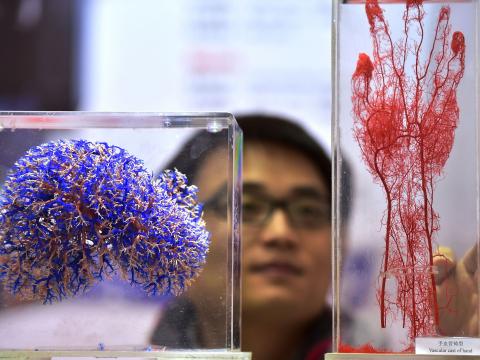Human organs made by 3D printers

Implanted in bestial body parts bones, cartilage and muscles made to a 3D Printer, function commonly, based on an published within the journal Nature Biotechnology that the outcome of the maturation of American.
Breakthrough discovery empowers usage of living tissue to restore damaged organs. Even a doctor - Professor in college London referred to as the new engineering "the goose that lays the Golden eggs".
The point will be to incorporate the human stem cells, generated onto a 3D Printer, a specific backup of this damaged manhood with the capacity of building an evolution from regenerative medication. Change out your cracked jaw, destroyed heart rate, or go back a lost man's ear utilizing this technologies will be difficult.
So far, the major dilemma of transplantation of unnaturally regenerated organs would be that the issue of preserving their usefulness - tissue depth exceeding 0.2 millimeters, deficiency of nutrients and oxygen.
A group of Western health center Wake Forest allow us a brand new procedure, that lets you make with a 3 d printer alive tissue that's teeming with micro-channels. The cloth includes a solid foundation which makes it possible for nourishment and neural networks to permeate into its own structure.
This tech has been an integral platform, a portion of that can be accountable for cartilage development and also one other for manufacture to a 3D printer precise replica of the model human anatomy.
The foundation material is composed of the biodegradable plastic that creates the outer arrangement of their rebuilt penis, also gel water-based, which comprises cells also stimulates the own growth.
Tests on animals revealed that right after implantation of this plastic is slowly shattered, and its particular place is an all-natural structural element of proteins generated from cells.
Blood nerves and vessels specifically into the implants. States Professor Anthony Atala, lead writer at the middle of Wake Forest, now it's already feasible to publish cells that are human, however scientists still wish to await the ending of monster screening to comprehend how solid the organs that are reconditioned.
Anyway, 3D printing opens up fresh chances for the drug. "Guess we obtained that a man with injury of their fascia, a portion of that will be lost. We're carrying the affected individual a CT scan, then transmit the info for the printer plus it'll cause the lost region of the eyebrow bone, and this will absolutely suit the affected individual." Tech utilizing Artificial substances that can be subsequently impregnated using an alternative with stem cells have been completely implemented.
2 decades in the past in the infirmary of Wake Forest executed experiments to both research lab grown feminine reproductive tissues, nevertheless generally option of this kind of processes is bound thanks to issues with preserving cell viability.
Whilst the Professor states Atala, inside their own latest experimentation has been the very several kinds of tissue - muscular, tender bones and also bones that are hard - that signifies the extensive chances of technology that is new.
Professor Martin Birchall at employed in operation at University College London, predicts for the outcome are equally spectacular.
"The possibility of employing 3D printing individual organs and tissue such as implantation had been actual, but that I acknowledge I didn't expect you'll see this rapid advancement. That which they will have been able to generate, could be predicted the goose that lays the Golden eggs!" - respected a physician.
In addition, he considers that earlier having to humans, you want to carry out extra studying, however, expects that it may need a while.
"Considering that the grade with this breakthrough exploration, advancement in different places, tools accessible scientists in Wake Forest and also the desperate requirement I presume that at over 10 decades, surgeons for example as me will probably soon be competent to execute surgeries published organs and cells. Don't wait patiently," provides Martin Birchall.
.png)